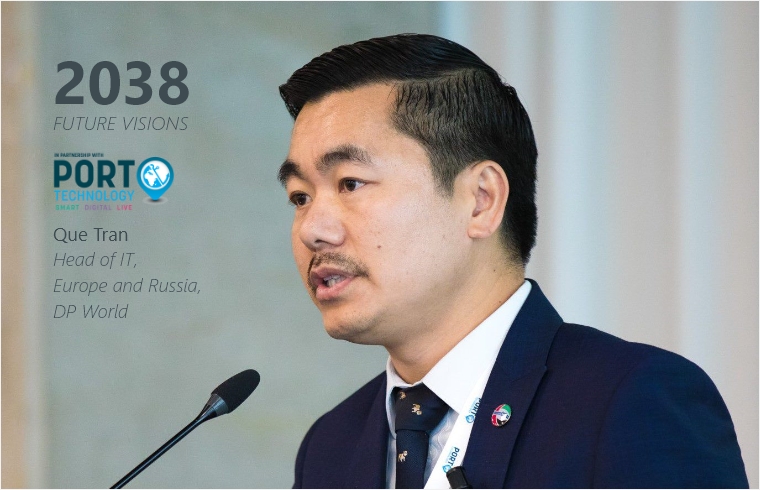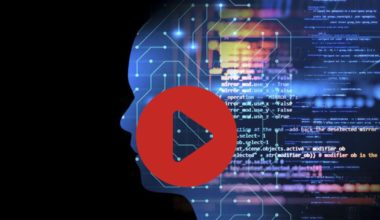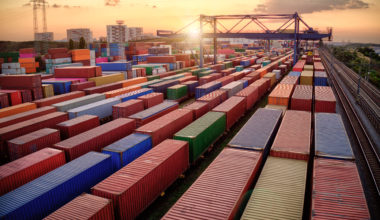Continuing our exclusive series in partnership with Port Technology, INFORM’s Matthew Wittemeier caught up with Que Tran, Head of IT for Europe and Russia at DP World, where they discussed his view of the maritime industry and what it’s got in store for the years to come.
Year: 2020
MW: In our book 2038: A Smart Port Story, the story opens following Douglas at a technology retreat at the Blue Lagoon, where he’s interrupted and finds a pod to connect to his office remotely. While pods rose as a solution to address environmental challenges; the prevalence of remote working in 2038 is crucial. Is the current pandemic paving the way toward a highly remote workforce of the future?
QT: I believe it is. It has really shown that. It’s shown how quickly we can adapt to the changing environment, and also the scale of how flexible a highly remote workforce can be. From my perspective, the technology components for a remote workforce have been in place for a long time. Still, it’s actually taken a global pandemic for this kind of, I would say, accelerated embrace of remote working and the truly digital and dispersed workforce.
This conversation is also telling. Using an online video tool to talk, I think, in essence shows that work is no longer a place where you go, but actually what you do. I think the traditional thinking of “work,” which is really attendance-based, is changing, and we’re moving toward what is actually an outcome-based work within a flexible workforce.
I think this remote method of working has truly shown that as well. Previously, typical interactions between the workplace and home were more about understanding a work-life balance, about how you manage the two. The challenge now is more about work-life integration because the work itself is at home in addition to home life.
On a positive note, I have been to the office a few times consistently across the course of the pandemic period. The current situation means that attendance at workplaces actually becomes a much more meaningful kind of transaction. Actually, it makes it a more productive environment when you need to be physically in a place of collaboration, whether it be a workplace or a meeting location.
MW: Ports and terminals haven’t stopped functioning during the pandemic. The equipment operators have had to continue to go in to work. Do you think there will be a shift toward offering them the same flexibilities with remote working opportunities, whether that be through an augmented environment or a virtual environment, in the coming future?
QT: Definitely. As we move more and more toward automation, those will be significant enablers. What has now been shown is that you no longer need to be physically present in a cab to operate the equipment. You can be remote in a remote office, essentially still within the vicinity of the port and terminal. But obviously, extending this beyond the terminal is really just about connectivity.
In addition, you vastly increase the actual diversity of the talent pool that can access work in a “port environment.” We know that historically the industry has been challenged just based on the location of the business. What you will have are opportunities for a more flexible working environment and hours. This will enable the industry to attract a different kind of workforce, who were previously unable to fulfill an attendance-based type of work. Again, whether that is in a centralized port office or even a home office, remote work brings a much greater scope of employability to the industry.
Year: 2025
MW: Many innovative technologies discussed in 2038 saw significant growth in the mid-2020s. What technologies, if any, do you see as being innovative and positioned to cause disruption in the maritime industry?
QT: It’s a fine line from my perspective. I always try to make sure people tread carefully on understanding innovation versus what is adding value. What we’ve seen is probably a lot of innovation over the last 10 or 20 years, but rarely does it produce tangible value. As soon as the value is not immediately seen, then the opportunities for that innovation and further adoption suddenly dissipate, and we move on. The idea is forgotten about, so to speak.
Look at AI. AI has been in the background for a while, and many organizations have used AI to understand data. We called it “analytics” prior. AI has been really about making, I would say, narrow-based decisions. But I think the opportunity with AI going forward is to use it for truly complex calculations, what we would now call “human-based decisions.” As much as it is disrupting right now, I think that will be one of the biggest innovative disruptors to the port and terminal industry and the wider maritime industry.
In addition, computing power, or “compute,” has advanced significantly over the past decades, and we always tend to use up as much compute as we have available. But quantum computing, which is just over the horizon, will exponentially increase the capacity for complex AI. Complex AI requires a significant amount of computing to process, interrogate, and understand data. As such, I think quantum computing and just the mass of complex compute that’s going to be available on the horizon will be very interesting.
Finally, there is automation to consider. I think we’re just on the cusp of automation, especially for our industry. Now, automation is really about rules-based decision-making, but what we’ll start to see more of in the coming decade is the self-maintaining and the self-directing of automation and robots. This will be an environment where most of the “rules” are stored and executed locally on the robot or machine. However, the AI in the machine itself will be self-interrogating, self-learning, and self-understanding the environment, with minimal oversight from a centralized system.
When you look at just simple things like maintenance today, it still requires humans. We have complex robots for automation, but people still do the maintenance. And the planning for maintenance is still done by people. Self-maintaining automation and equipment, I think, will become quite a big opportunity.
MW: The industry’s historically not quick to adapt to innovative technologies. I love what you’re talking about, for instance, with quantum computing. However, I can definitely see quantum computing being something that the industry looks at for two decades before deciding they’re sticking their toes in it. Would you agree or disagree?
QT: What we tend to find is that we overestimate how quickly we will adopt things. Just looking at something like blockchain, the consortiums have been in place across the industries for the last few years without a huge amount of visible progress. You see that the adoption of technology becomes a lot quicker over the long term, which we tend to underestimate.
And I think with something like AI, which requires massively complex algorithms and capabilities, you’ll find some of the truly innovative companies and industries, and I would add countries, are placing many of their investments in this technology. They know they will then be able to leverage these investments in AI because of the additional computational power that quantum computing will bring.
And I think we’re really on the cusp of that when you look at things like autonomous vessels, ways we can ensure more operational efficiencies, and safety and regulations. I think that’s where the massive compute will really, truly come in because it will become a much more complex environment.
Year: 2030
MW: The impact of technology is used as a frame in 2038 to look at many broader social, economic, environmental, and business trends. What trends do you think will shape the future, and what can we be doing to influence them today?
QT: There are certain trends we’ve seen, things like population growth and the acceleration of megacities. I would especially say that’s true in places in Asia, where a 10-million-plus population in a city is not a rare occurrence. Looking beyond Asia, places are springing up in the Middle East and also in Africa, which is now the high-growth population area. I think that’s going to lead to increasingly concentrated geographies of increasing consumption. So, there is still a big growth opportunity and consumption in that continually growing population.
I think that is where there are opportunities to understand what technology can bring to these fast-growing megacities – be it automation, be it planning, be it social and public services, and how we better plan these. These opportunities include details like food versus consumption and understanding how to have the actual resources and materials in the place where they’re going to be consumed. With food, we’re talking about vertical farms. These ideas lead to better understanding and sustainability, things like an increase in micro-level farming and moving toward self-sustaining cities in certain respects.
Also, climate change is a big, big, big factor, especially when paired with resource scarcity. I think moving forward toward more green and sustainable energy and having a more circular economy and pushing that, ideas like the rapid charging of electrified vehicles, will greatly accelerate their adoption.
Population demography and the social change that brings will also be important. An example is the aging populations in certain parts of the world and the imbalances of ages across geographies around the world. I think I talked about rising education levels and knowledge workers in other regions in the world. That also causes societies to change their traditions, such as their cycle of learning and work and play. Where you look at the expectations, we’ve improved medication and health care outcomes. Obviously, at this moment in time, we’re probably not thinking about that , but the actual life expectancy is continually expected to increase over time.
We look at a traditional cycle of life. In basic terms, that is you learn for the first 20 to 25 years of your life. You work for the next 30 years. Then you have time to play for the remainder. But, when you look at it now, those broad categories are already changing, and it’s not a straightforward three-stage cycle. It becomes a five-stage cycle or even a seven-stage cycle system. You may do some playing in between working, you come back to learning again, and so forth. As we adapt to new roles with new skill sets and the required adjustments, that traditional cycle becomes very different. The technologies you can bring to help people both work and learn or play and work will be interesting.
Finally, there is connectivity. I’ve touched on connectivity already. The assumption is where we are today is that the internet is everywhere, but we know that’s not the case. Moving forward, what we will see potentially is connectivity ubiquity. That brings an increased number of new opportunities, I would say, in where work happens, but also in where populations move to, but as well, where growth can happen too. With connectivity ubiquity, we see the reverse trend of concentration in megacities that may give opportunities to release those cities’ stress.
Year: 2035
MW: Without giving too much away for those who’ve not read 2038, as we move toward technologically augmented environments, cybersecurity is increasingly a topic we all need to understand intimately. Where are we now? And what will cybersecurity look like in 20 years’ time?
QT: Cybersecurity has become a massive agenda throughout different industries, but it is particularly relevant to the ports and terminal business. I think the Maersk attack in 2017 was a big wake-up call to the industry. Traditionally, cybersecurity was treated as a nice-to-have – something we do at the very end. And in reality, that means we don’t have time to do it, and it gets forgotten. It was seen as a very onerous overhead.
Traditionally, I would say, security was previously sort of a projection of how kingdoms were protected, with large walls and moats – big hardware solutions. The assumption was we needed to create a perimeter to protect, and we protected what was inside that perimeter. But we’ve moved away from that, especially with cloud and remote work. We’ve seen that actually the perimeter itself has changed.
What’s more, we’re moving on from passwords. Traditionally, everything was protected by passwords, and we’ve seen how easily that can be compromised. Moving to two-factor and multifactor authentication is the trend, and I think that’s where we’re at right now. We’re making the transition to understanding there are other forms of protection and that we’re protecting multiple things simultaneously. The future of cybersecurity is in fully trusted computing, which is everything has to be trusted for the first time, every time you connect.
Going forward in the future, we actually need to protect everything that is connected. So, we’re talking about not just computers, servers, etc. We’re talking about vehicles; we’re talking about vessels; we’re talking about actual entire megacities and the underlying infrastructure in those cities. We’re talking about how that’s all protected.
Year: 2038
MW: We’ve reached the year 2038. And sadly, that means we must draw our interview to a close. In the minute or so we have left, what’s the one thing our readers should take away from this interview?
QT: One of the key things I mentioned is that we tend to overestimate technology capabilities in a very short time window, say under two years. We think things will move along a lot quicker than they can. But actually, we vastly underestimate technology’s progress over a longer time window, say 10 years. Look at your smartphone; it’s evolved in leaps and bounds. Think about what you can do with your smartphone now versus 10 years ago. Absolutely huge! Also, I think people are generally resistant to change. Still, what we’ve seen in the last six months, the other side of the coin, is we can also adapt tremendously quickly, and that’s with respect to new technology, business, or social changes that the future brings.
MW: Que, thank you very much for your time.
QT: Thank you, Matthew.
Who is Que Tran?
Que has over 20 years of senior IT leadership experience within international organizations across a range of sectors, including media, market research, manufacturing, maritime, logistics, and financial services. He also served as a diplomat with the Commonwealth Secretariat. In addition to technology leadership, he is focused on cyber, digitalization, and innovation initiatives to help protect, optimize, and transform the organization and industry. Beyond his role as Head of IT in Europe & Russia at DP World, a leading enabler of global trade and an integral part of the supply chain with over 150 operations in 40 countries, he is also currently Director of IT for P&O Ferries.
What is 2038: Future Visions?
2038: Future Visions is a series of interviews from leading maritime logistics professionals who share their view of the future of our industry in the year 2038. It is brought to you in partnership with Port Technology. 2038: Future Visions builds on the award winning 2038: A Smart Port Story, which INFORM published in 2019.
What is 2038: A Smart Port Story?
2038: A Smart Port Story explores the terminal of the future and the intricacies of technology and its impact on both the port industry and society. Join Douglas as he unravels the mystery around an incident at the Port of Reykjavik that sees an AGV collide with a human, leaving their life hanging perilously in the balance.
Haven’t read 2038: A Smart Port Story yet? Get started with Part 1 today!
More from the World of 2038 – The Athena Interviews
The Athena Interviews is a series run in 2019 in which INFORM’s Matthew Wittemeier interviewed the main AI character from 2038: A Smart Port Story about a broad range of topics surrounding AI. In an interactive video format, readers/viewers are introduced to Athena as together they explore thought-provoking questions about the future of logistics, technology, and AI.
Missed the beginning of The Athena Interviews? You can pick it up from the start at PTI Exclusive: Athena Q&A Part 1.


